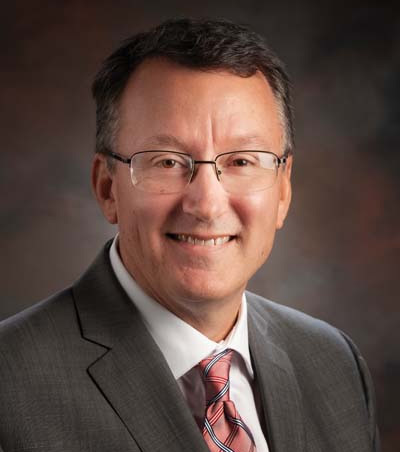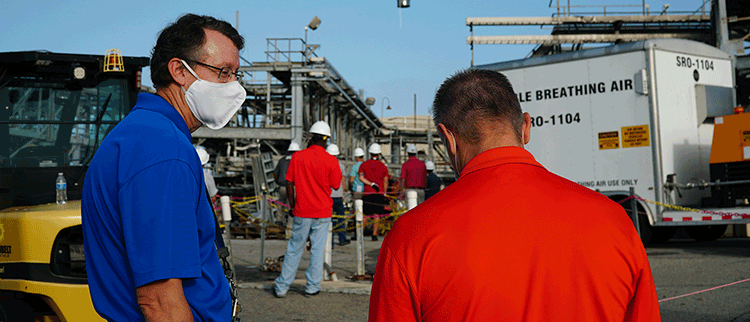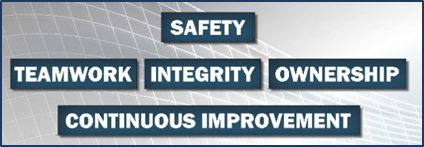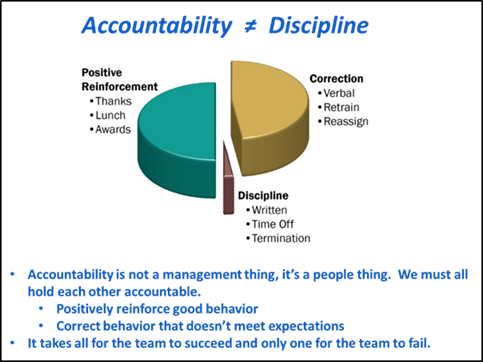2021 CEOs Who 'Get It'


Phil Breidenbach
SRR PresidentSavannah River Remediation
Aiken, SC
Savannah River Remediation’s mission is to eliminate the most significant environmental hazard in South Carolina. Its 2,600 employees do that by taking a hazardous, radioactive liquid waste stream – which is stored in 43 1.3-million-gallon operational underground tanks – and converting it into two safe, solid forms that can be disposed of and will be stable in the environment for 10,000 years.

Describe your personal journey to becoming a CEO who “gets it.”
Who we are as a people, organization and company is described by the values we espouse. These values describe “how” we will conduct our work. When things get messy and the direction is not clear, it is these values that shine a bright light in the direction we should go. The core values can change slightly based on the company and organizational needs, but I have found they don’t change much or often. For high-hazard nuclear work, this is the set that I have come to rely on, and it is what we have in place at SRR:

Every company, even the bad ones, has a set of values. They have a poster on the wall – and that’s all it is. We must work every day to make these more than a poster on the wall, more than words on a page. We need to work to get these values into our hearts and minds so that they guide our behaviors when times get tough and the path is unclear. These are simple words, but they tell a lot about who we are and who we want to be. They form the foundation on which everything we do is built.
Sometimes I get asked what things I think are important to success. I always answer with the five vowels:
A is for attitude. It comes first, and it is probably the most important. When is the last time you saw a person who you thought was successful who had a negative attitude? I can’t name one. All of the people who I consider successful are almost always positive, looking forward, constantly trying to improve and excited about the future. Lou Holtz, a very successful college football coach, put it this way: “Ability is what you’re capable of doing; motivation determines what you do; attitude determines how well you do it.”
E is for effort. This is the one nobody likes. Anything worthwhile takes effort – sometimes a lot of effort. Sometimes it requires you to get up earlier than you wish and to work at it longer than you want. I believe this is true in all aspects of your life – personal and professional. And there will always be people who tell you that you’re trying too hard, that it’s not worth it. You should listen, but never forget, only you can decide. They aren’t you. Mark Twain put it this way: “The dictionary is the only place where success comes before work.”
I is for integrity. In his book (and video) called “The Last Lecture,” Randy Pausch said it best: “If you allow me to give you three words of advice, they would be, ‘Tell the truth.’ If you let me give you three more, they would be ‘all the time.’” Tell the truth, all the time. It sounds so simple – something you learn from your parents and is reinforced in grade school. Yet it is so hard to do, all the time. As a mentor once told me, when you make a mistake, the best thing to say is, “I’m sorry. I’ve learned from it, and I will try hard to never make that mistake again.” Better than to just say the words is to really mean it, to live it.
O is for ownership. Don’t go through life being a renter. Have you ever noticed when you rent something, you don’t treat it exactly the same way as when you own it? It’s that way with me – if I rent a car, I don’t wash it. I don’t clean it out. I don’t park it places where I won’t get door dings. At work, we need to act as if we own the site, not like we are renting it. If something is dirty at work, think of it as if it were in your living room. If something doesn’t work, think of it as being in your house, in your kitchen. Find something at work – large or small – and own it. Make it yours!
U is for you! In the end, your success is all up to you. Others can help, but they won’t do it for you. It takes a positive attitude, effort, integrity and ownership. The good news is everyone can do those things. Everyone can be successful, but it is up to each of us as individuals. It is up to you.
What, how and why … I think these are critically important to our success as a company and individual success as a leader.
Every individual needs to know “what” needs to be done today. “What” needs to be coordinated. If we are playing football and the linemen think it’s a passing play and the receivers think it’s a running play, then we aren’t going to get very far. Everyone needs to know “what” we are trying to accomplish and “what” they need to do for the team to succeed. People don’t automatically know “what” – someone needs to guide them. We do a lot of things to make sure everyone knows “what” we are trying to do. Schedules show “what” we are trying to do and when we are trying to do it. We conduct pre-job briefings where we talk about “what” we are going to do. We have staff meetings, integration meetings and plan-of-the-week meetings – all trying to make sure everyone knows “what” we are trying to accomplish.
But we all need to know more than just “what.” We also need to know “how.” In this case, “how” relates to the standards of performance. We need to know “how” work is conducted here, in this company, at our site. That could be very different than “how” work was conducted at the last place we worked. I was in a critique one time related to our response to a small, candle-sized fire that happened on a job. The worker simply tapped out the fire with his glove and finished the job. We all agreed that the job should have stopped, and the fire should have been reported. When I asked the worker why he didn’t stop and report, he said, “If I had stopped for something like this on my last job, I would have been fired on the spot.” The worker had worked for us for only two months. People don’t know “how” automatically. It must be explained and reinforced. “How” to do work is described by our values and expectations. As a leader, if you are not satisfied with “how” work is being conducted, you will likely find the root cause by looking in the mirror. Always remember that standards of performance will never be higher than those you are willing to accept.
“What” and “how” are important, but they are not enough by themselves. People also need to know “why.” “Why” is what motivates you. It is what gets you out of bed in the morning. It is what gets you up after you get knocked down. It is what helps you remember “what” and “how.” At SRR, we get to do something special – something of national importance. We are eliminating the highest environmental risk in the state of South Carolina. We make the world safer. We make the world cleaner. What we do is special. Not everybody gets to do something so important. Like the “what” and “how,” people don’t automatically know “why” what they do is important – someone needs to tell them. You’re someone! And to the people you work with, your opinion matters.
I challenge you each day to talk about what, how and why. Reinforce our values and expectations. Don’t accept things that don’t meet our standards. Constantly remind each other of the importance of our work.
What is the biggest obstacle to safety at your organization, and how do you work to overcome it?
Safety is hard in any organization because we get by with being unsafe so often. You almost never get hurt the first time you take a shortcut. You get by with it, and pretty soon it becomes a habit – a bad habit. It becomes the standard way work is done. We don’t even realize it is unsafe. Left unchecked, those bad habits will continue until one day, when everything lines up, someone gets hurt – maybe badly.
It always takes a little more effort to do a job safely. You need to do a pre-plan or have the right tools or personal protective equipment. Humans are always looking for the easiest, most efficient way to get a job done. To truly work safely, we have to not just tell people what to do and how to do it, we have to explain why that’s the right way to do it. Only when they understand why will we get the behaviors and performance that lead to exceptional safety.
We are all creatures of habit – this applies to safety also. We have to have processes in place that can help people identify and correct their bad habits and positively reinforce their good habits. This is where behavior-based safety and management field observation programs come in, and it is why they are so important.
Why is safety a core value at your organization?
In the high-hazard nuclear business, you don’t get to conduct your mission unless you can do it safely.
I was born and raised on a farm. Farming is a dangerous business – next to mining, it is probably the most dangerous industry in the United States. I believe that’s because you are constantly working around heavy equipment, and you are typically working alone. We did a lot of work growing up, and I made it through without getting hurt. We didn’t have much in the way of pre-job briefings, procedures or work packages. The only oversight was my dad, and he was usually a long way away.
When I started working at the Savannah River site in the mid-1980s, I was shocked by the level of documentation, rigor and time required to do work. It didn’t make sense to me, and I actually almost quit the industry. Slowly I started to understand why it was different than what I was used to on the farm. On the farm, I could certainly hurt myself or maybe someone I was working with, but not much more than that. I could certainly start a fire and burn up a field – I might have done that once. I could put the wrong pesticide or herbicide on a field and cause a serious problem. But I’d have a hard time affecting the state or the country. I’m not sure I could affect the farming industry as a whole on my little farm in South Dakota.
In the nuclear business, we can. If we don’t do the work correctly, we can affect many people, large areas of the state and the entire nuclear industry. Think about Chernobyl or Fukushima. Because the consequence can be so significant, the controls to ensure we don’t actually experience those consequence need to be so robust. That’s why we use engineered controls, plan the work, comply with procedures, etc.
That is why in our business, safety is a value. More than a priority, because priorities change. It is a value and it always will be.
How do you instill a sense of safety in employees on an ongoing basis?
Constantly talking about safety is important, but it is not enough. Training people how to work safely is necessary, but it is insufficient by itself. To me, the key is holding people accountable.
Most people equate accountability with discipline. I believe that when accountability is done right, discipline is a very small piece of accountability. And if it were done perfectly, discipline would never be necessary.

The way I like to think about accountability is that it comes in three types: positive reinforcement, correction and discipline.
Positive reinforcement is a type of accountability. When you find someone doing the right things in the right way, you should hold them accountable. We can do that in many ways: by thanking them, taking them to lunch or giving them some kind of reward. The only thing we shouldn’t do is ignore it, because if we do, those good behaviors will disappear over time.
Sometimes people don’t do what we want them to do or in the way we want them to do it. Sometimes people don’t meet our expectations. It is not normally on purpose – no one intentionally wants to make a mistake or disappoint someone. This is when correction, or coaching, is necessary. Correction doesn’t have to be mean. It can be done in a constructive manner. It is part of being a team. If we don’t correct behaviors that don’t meet expectations, they will continue or get worse over time. This is how individuals and companies fail.
If we don’t do positive reinforcement and correction well, performance will degrade, and we will be left with discipline. I’ve seen this happen. In one facility at which I worked, they were exceptional at discipline. The discipline system was rigorous, and we had an eloquent system to ensure it was done consistently and per procedure. And we exercised it frequently because there was no process for positive reinforcement or coaching – those things were almost never done. As a result, issues grew, and the only thing left was what they knew how to do well – discipline. We changed that by the time I left that facility, and I assure you, we don’t want to be where they were at the beginning. Our goal should be to do positive reinforcement and correction so well that discipline is unnecessary and it all but disappears.
The last point I’ll make is that accountability is not a management thing, it’s a people thing. It has very little to do with your level in an organization or if you are a manager or a worker. I want each of us to hold each other accountable. I want workers to hold me accountable for doing my job and for doing it in a way that is consistent with our values, expectations and standards. I would hope they expect me to do the same for them. In my mind, we are a team, and team members hold each other accountable. It is how we grow as individuals, and it is how we succeed as a company.
How does your organization measure safety? What are the leading indicators that show you how safe your organization is, and where do you see room for improvement?
The leading indicators that show our safety are:
- Behavioral observations – observing both safe and at-risk behaviors, and providing coaching for at-risk behaviors
- Management field observations – these interactions provide an opportunity for the leadership to observe work activities, coach for improvements, and thank workers for conducting activities in a disciplined manner and taking their safety and the safety of co-workers personally, 24/7
- Safe days – recognizing our accomplishments and thanking the team for following procedures and keeping each other safe
- Safety meeting attendance – this metric shows that personnel is actively supporting safety programs and initiatives
- RAVE/ROAR/Catch of the Week recognition – positive reinforcement programs in place at SRR to encourage the demonstration of our values, expectations and standards
- Safety messages – this provides us the opportunity to actively share best practices, lessons learned and general safety reminders
Leading indicators are important. They give you a chance to identify a problem while it’s small and fix it before it gets big. It is also important, though, that we look at lagging indicators. For us, those are reportable events and injury rates:
- Occurrence Reporting and Process System reportable events
- Injury statistics
It is important that we pay attention to both. A great analogy would be if I were trying to lose weight. I should really pay attention to the leading indicators: Am I eating healthy foods, in the right amount and getting exercise? If I do those right, I’m on the path to lose weight. But the moment of truth is when I step on the scale. Did I gain or lose weight? That’s a lagging indicator, but you’ll never know for sure until you measure it.
What role does off-the-job safety play in your organization’s overall safety program? What types of off-the-job safety and health programs does your organization offer to employees?
Safety is one of our company values at SRR, which supports the overall foundation of our Nuclear Safety Culture. One of the expectations under the value of “safety” is, “Take your safety and the safety of your co-workers personally – 24/7.” So, I believe that off-the-job safety is a byproduct of our on-the-job safety. It is only natural that during the course of upholding our safety values in our day-to-day work activities that this value becomes a personal value to our employees. At SRR, we start all meetings with a Nuclear Safety Culture message, and presenters are free to develop their own message. We frequently hear our employees talk about personal stories and how they apply safety in their personal lives. It is amazing to hear how the same safe behaviors and critical thinking we apply in a work environment that processes nuclear waste are applied by our employees in their personal lives and home projects. It is evident that these values are instilled in the next generation as our employees’ mentor their kids and grandkids and teach them what safety means.
What have you done to support employee mental health and well-being within your organization?
We have recognized over the years that a safe and healthy workforce does not start and stop at the gates of our site. We have an obligation to support our employees’ ability to live a healthy lifestyle. It is a win-win when a healthy and happy employee arrives to work physically fit and with a clear and focused mind. That means they can conduct their job duties in a safe and disciplined manner.
Some of the steps we have taken to support our employees’ health and well-being include the formation of “Health Kiosks” throughout our facilities. These kiosks allow employees to treat minor ailments (headaches, sore throat, etc.) with over-the-counter medication, check their bodyweight and body mass index, and check their heart rate and blood pressure. These kiosks include self-help literature to support awareness and give employees some considerations for taking further action if improving their wellness is desired.
We have created companywide health challenges called “The Biggest Winner” (a play off a TV network weight-loss competition), where teams are formed and support one another with health lifestyle changes to lose weight and increase their overall well-being.
Knowing how hard our employees work and the challenges of finding time in their personal lives to be proactive with their health, we have coordinated various onsite health fairs and flu shot clinics where employees can take those needed steps in identifying health concerns and be proactive in their care. We also offer ongoing health education via “lunch and learns,” where guest speakers provide 30-minute educational sessions during lunch breaks, allowing employees to eat lunch and obtain new information on health and well-being.
During the COVID-19 pandemic, we are routinely checking in with our personnel who are teleworking to ensure they see/hear a friendly voice. This action provides us the opportunity to gauge the overall health and well-being of our teammates.
In addition, the benefits package we offer covers mental health services for employees and their family, and we also have an onsite employee assistance program for employees that are having any mental health issues.
Post a comment to this article
Safety+Health welcomes comments that promote respectful dialogue. Please stay on topic. Comments that contain personal attacks, profanity or abusive language – or those aggressively promoting products or services – will be removed. We reserve the right to determine which comments violate our comment policy. (Anonymous comments are welcome; merely skip the “name” field in the comment box. An email address is required but will not be included with your comment.)


